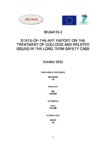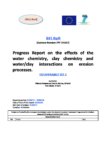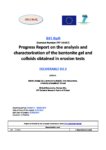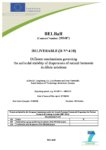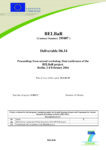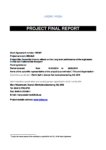BELBaR: Bentonite Erosion: effects on the Long term performance of the engineered Barrier and Radionuclide transport
The BELBaR project aimed to increase knowledge of the processes that control clay colloid stability, generation and ability to transport radionuclides. The overall purpose of the project was to suggest a treatment of the issues in long-term safety assessment.
Overview
Project Dates: 01/03/2012 – 29/02/2016
Project Status: Finished
Project website: https: www.skb.se/belbar/
The main aim of the BELBaR project (Bentonite erosion: effects on the long term performance of the engineered barrier and radionuclide transport) was to increase knowledge of the processes that control clay colloid stability, generation and ability to transport radionuclides, which are important processes occurring in geological disposal of radioactive waste. Experiments conducted and models developed within the scope of the project aimed to reduce uncertainties associated with erosion as well as instability issues in engineered barrier systems (EBSs) and fractured host rock.
The formation of clay colloids may degrade the EBS and adversely affect transport of radionuclides, reducing the efficiency of the natural barrier. Scientists therefore began by determining the conditions required for colloidal stability as instability and short lifetimes would make it unnecessary to include them in updated models.
Researchers then focused on improving quantitative models for erosion of the EBS for those scenarios in which the colloids are stable. This included increasing understanding of radionuclide attachment to and transport by clay colloids to realistically model processes.
Scientists also developed several experimental setups to evaluate transport of radionuclides in stagnant water and in fractures. The latter included artificial fracture systems to study extrusion of swelling clay into nearby fractures. Results from a range of conditions suggested strong colloid attachment to fracture surfaces even under unfavourable scenarios.
The consortium also investigated colloid stability and investigations of five different clays from five different origins. This showed growing aggregation resulting in the destabilisation of colloids with increasing ionic strength.
BELBaR aimed to reduce the assessed overall risk of a repository and guide future site selection characterisation programmes. It also aimed to support the selection of engineered barriers for a nuclear waste repository.
One unique aspect of the project is the short step from fundamental science to industrial application. Hence, the project aimed to be of significant value to the scientific community, especially the fields of surface and colloid chemistry.
The project had a strong focus on cooperation and integration. This was achieved by exchange of staff between partners and arrangement of frequent seminars.
The BELBaR consortium consisted of research institutes, implementers and universities from within and outside the European Union.
Objective
Safety assessments for nuclear waste repositories have shown that the formation and stability of colloids may have a direct impact on the overall performance of the repository.
The main aim of the BELBaR project was to increase knowledge of the processes that control clay colloid stability, generation and ability to transport radionuclides. The overall purpose of the project was to suggest a treatment for the issues in long-term safety assessment.
The key areas of research were:
- Erosion of bentonite buffers – the main objective of these studies was to understand the main mechanisms of erosion from the bentonite surface and to quantify the extent of possible erosion under different conditions.
- Clay colloid stability studies under different geochemical conditions – the colloids formed at the near/far-field interface would be stable only if favourable conditions exist and therefore their relevance for radionuclide transport will be strongly dependent on the local geochemical conditions.
- Interaction between colloids and radionuclides and the host rock – how colloid mobility may be affected by the composition of the host rock and the mechanism of sorption and de-sorption of radionuclides on the colloids.
In these areas substantial laboratory studies were undertaken. Modelling studies supported the laboratory studies through development of conceptual and mathematical descriptions of the observed phenomena.
The final outcome was to consider how colloids and related phenomena can be considered in the long-term safety case and to make recommendations on how the safety case could address this potentially very significant issue.



